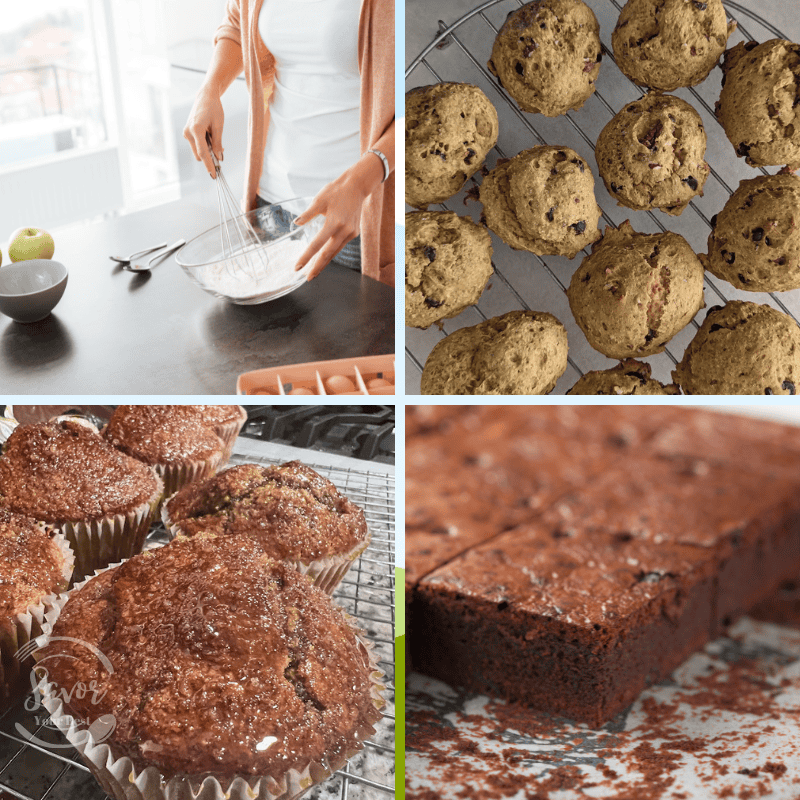Fall is the perfect season for all things warm, cozy, and delicious, and baking with fall spices is at the top of the list. Baking with apples evokes memories of crisp autumn days. But what if you could take your baking up a notch with freeze dried applesauce? Healthy baking with freeze dried applesauce is a great way to replace oil, butter, or sugar in recipes while boosting nutritional content. Yes, you read that right! Freeze dried applesauce is not just a tasty snack on its own; it’s also a fantastic ingredient for healthy baking. Imagine all the flavor of fresh applesauce without the mess or added moisture that can throw off your recipes. With freeze dried applesauce, you get the best of both worlds—flavor and convenience.
When you use freeze dried applesauce, you’re keeping all the goodness of fresh apples. The freeze drying process preserves the natural sweetness, tang, and nutrients of the apples without adding any preservatives or sugar. That means you’re baking with a whole food ingredient that’s as close to fresh as you can get. Plus, it’s lightweight, shelf-stable, and easy to store, so you can always have some on hand for whenever that baking urge (or sweet tooth) strikes!
Applesauce as a Healthy Substitute in Baking
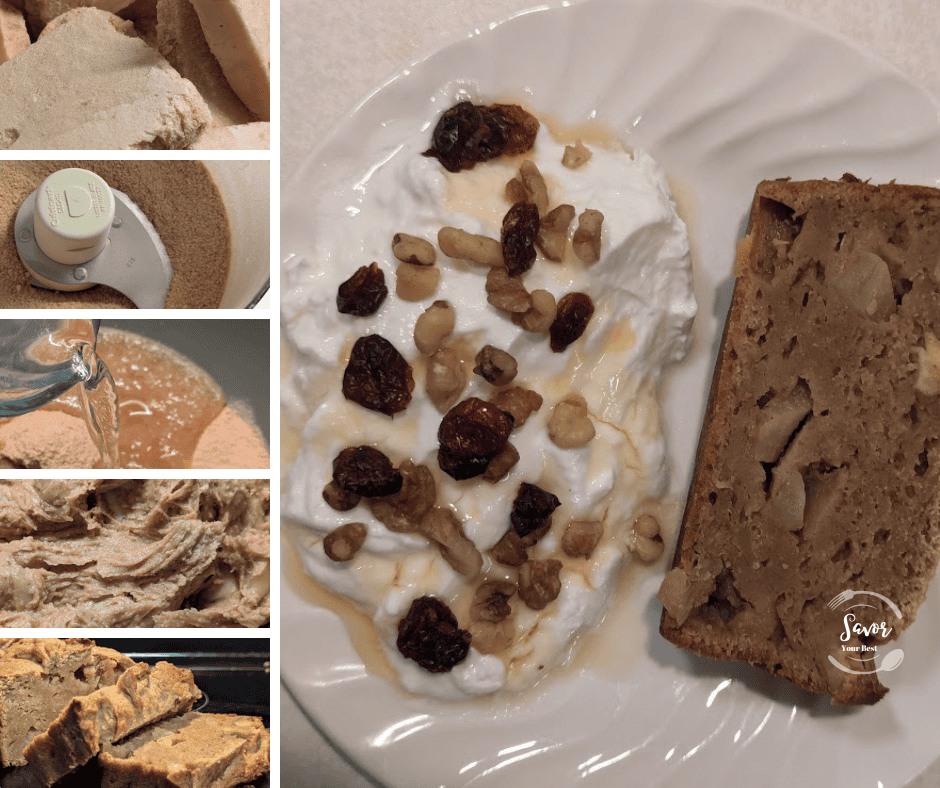
Freeze dried applesauce isn’t just for adding apple flavor; it’s a versatile substitute that can replace less healthy ingredients in your baking. One of the best uses for applesauce is as a substitute for oil or butter in recipes. This swap works well in muffins, cakes, quick breads, and even some cookie recipes. By replacing half or all of the butter or oil with applesauce, you can significantly cut down on the fat content while still keeping your baked goods moist and delicious. This means you’re reducing empty calories and saturated fats, making your treats a lot better for your heart and waistline!
Enhancing Nutritional Value with Applesauce
Using freeze dried applesauce in place of traditional ingredients doesn’t just lower fat; it also boosts the overall nutritional value of your baked goods. Apples are packed with fiber, which helps keep you full and supports good digestion. They’re also rich in antioxidants like vitamin C and phytonutrients, which can help fight inflammation and support your immune system. Plus, the fiber in the applesauce can help add structure to your baked goods, making them more filling and satisfying. When you use applesauce in your baking, you’re incorporating these benefits into every bite.
Applesauce can also be used as a substitute for sugar, thanks to its natural sweetness. If you’re trying to cut back on sugar, applesauce can be a great way to do that without sacrificing taste. It works especially well in recipes where a moist texture is desirable, such as muffins, cakes, quick breads, and even some cookie recipes. By swapping out some or all of the sugar with applesauce, you’re not just reducing the sugar content—you’re also adding vitamins, minerals, and fiber, turning an otherwise nutrient-poor treat into something with real health benefits.
For example, if you’re making a batch of pancakes or waffles, adding freeze dried applesauce can increase the fiber content and provide a dose of natural sweetness without the need for extra syrup. It’s a sneaky way to add fruit to breakfast favorites, which can be a big hit with kids or picky eaters. You can also mix it into batter for homemade granola bars, adding flavor and nutrients to a snack that’s perfect for on-the-go or school lunches.
Improving Texture
Another fantastic benefit of using applesauce is how it improves the texture of baked goods. It keeps cakes and muffins moist without the need for excess fat. This is particularly useful in gluten-free or whole-grain recipes, where the crumb can sometimes turn out dry or dense. The pectin in applesauce acts as a binder, helping to create a better texture and preventing your treats from crumbling apart. This is a huge plus if you’re experimenting with healthier flours like almond or oat flour.
Perfect for Specialized Diet Baking
Applesauce is an excellent substitute for those following special diets due to restrictions or personal choices. It works well in sugar-free or dairy-free recipes, offering a natural alternative that enhances your baking with great results.
A perfect example is using applesauce as an egg substitute in vegan baking. While flax eggs are often a go-to, they sometimes lack the moisture and binding power that real eggs provide due to their lower fat content. Applesauce, with its natural moisture and pectin, offers both the binding and moisture needed in baked goods. Replace one egg with 1/4 cup of applesauce in recipes like cakes, muffins, and quick breads. This simple swap not only keeps your treats egg-free but also boosts moisture and flavor, making your baking more inclusive without needing special ingredients or compromising on taste and texture.
This is also especially useful if you’re baking for people with allergies or food sensitivities. The next time you’re whipping up a batch of cupcakes for a classroom or a family gathering, you can confidently use applesauce as a substitute, knowing it’s a crowd-pleaser that fits various dietary needs.
Reducing Caloric Content
Replacing high-calorie ingredients like butter and sugar with applesauce also slashes the calorie count of your recipes, making them more waistline-friendly. For instance, swapping half the butter in a standard muffin recipe with applesauce can save you up to 500 calories in the entire batch! That’s a big difference, especially if you’re watching your calorie intake but still want to enjoy your favorite treats.
Why Freeze Dried Applesauce?
Using freeze dried applesauce in baking offers two major benefits: precise measurements and less food waste. Additionally, using freeze dried applesauce over regular applesauce in your baking is the control it gives you over moisture content. Traditional applesauce can sometimes make your baked goods too moist or dense, which isn’t always ideal, especially in recipes like muffins or quick breads. With freeze dried applesauce, you get all the flavor without the added liquid, allowing you to adjust the texture exactly how you want it. It’s a great way to add sweetness and nutrition without compromising on the fluffiness of your cakes or the crispness of your cookies.
Precision with Freeze Dried Applesauce
Traditional applesauce can be a bit tricky when it comes to measurements. Its water content can vary from batch to batch (or brand to brand), which means that adding it to your recipes might sometimes make the batter too wet or the dough too sticky. This can throw off the texture and consistency of your baked goods, making them denser or more moist than intended. With freeze dried applesauce, you get a consistent, concentrated ingredient that allows you to measure with precision every time.
Freeze dried applesauce can be processed into a lightweight powder form, which makes it easy to portion out precisely as you need for your recipe. You can even adjust the amount to achieve your desired texture—whether you want a hint of sweetness or a more pronounced apple taste. This kind of control is particularly helpful in recipes like cakes, muffins, or cookies, where the balance of wet and dry ingredients is crucial. Instead of guessing how the moisture in traditional applesauce will affect your batter, you can simply add water back to the freeze dried powder in controlled amounts, ensuring your baked goods turn out just the way you want them.
Less Food Waste with Freeze Dried Applesauce
Another huge advantage of using freeze dried applesauce is the reduction of food waste. Fresh applesauce has a limited shelf life, and once opened, it needs to be used relatively quickly before it spoils. This often leads to unused portions going bad and ending up in the trash. Freeze dried applesauce, on the other hand, is shelf-stable and lasts much longer, meaning you can use exactly what you need without worrying about the rest going to waste. It’s perfect for those times when you only need a small amount for a recipe or when you want to stock up without the fear of spoilage.
By incorporating freeze dried applesauce into your baking, you’re making your recipes more precise and reliable and doing your part to cut down on food waste, allowing you to keep your kitchen efficient and sustainable.
How to Use Freeze Dried Applesauce in Your Recipes
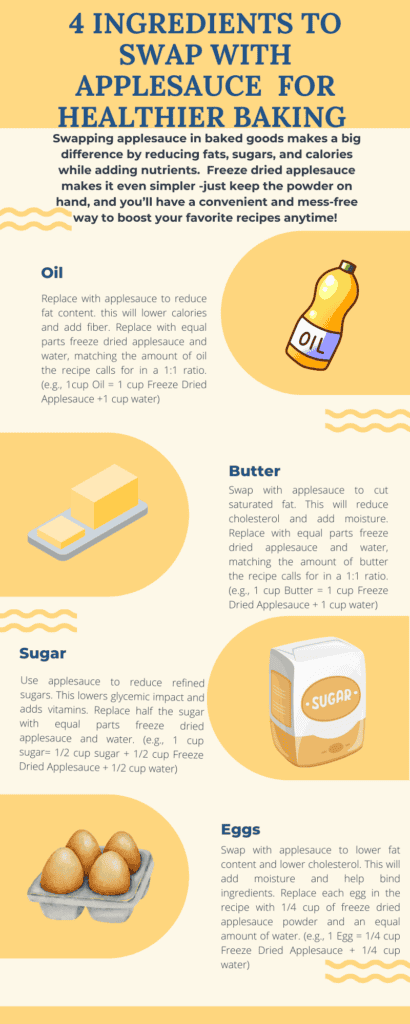
Using freeze dried applesauce in your recipes is super simple. To substitute in your recipes, use a 1:1 ratio of freeze dried applesauce powder and equal parts water to replace oil or butter. For eggs, replace each one with 1/4 cup of freeze dried applesauce powder and 1/4 cup of water. For sugar, it’s flexible—replace half or all of the sugar with equal parts freeze dried applesauce powder and water based on your taste preference.
You can either rehydrate the freeze dried applesacue with a little water to bring it back to its original applesauce form or use it as a powder. If you’re making something like muffins or pancakes, you can add the powder directly to your dry ingredients for a subtle sweetness that’s evenly distributed throughout. If you prefer to use it rehydrated, just mix the freeze dried applesauce with a bit of warm water until it reaches the consistency you need.
And if you’re feeling extra adventurous, try using it in savory dishes, like apple-stuffed pork chops or as a seasoning for roasted veggies. The possibilities are endless when you have freeze-dried applesauce in your pantry.
Why Freeze Drying Applesauce at Home is Worth It
If you have a freeze dryer, you can make your own freeze dried applesauce at home. This lets you control exactly what goes into your applesauce—no added sugars or preservatives, just pure apples. You have complete control over the ingredients—right down to the variety of apple you use, depending on your taste preferences and baking needs. You can choose the freshest, purest apples without any additives or preservatives, ensuring a healthier product. Plus, by buying in-season apples, you get the best quality at the lowest cost, and freeze drying lets you preserve that peak freshness for use all year round. This way, you always have a stash of pure, versatile applesauce ready for healthy baking or snacking.
Homemade freeze dried applesauce is a simple swap that packs in flavor, nutrients, and convenience, making it a must-have for healthy baking. Give it a try, and you might just find it becomes your new favorite pantry staple!
Choosing the Right Apple for Baking Substitutes
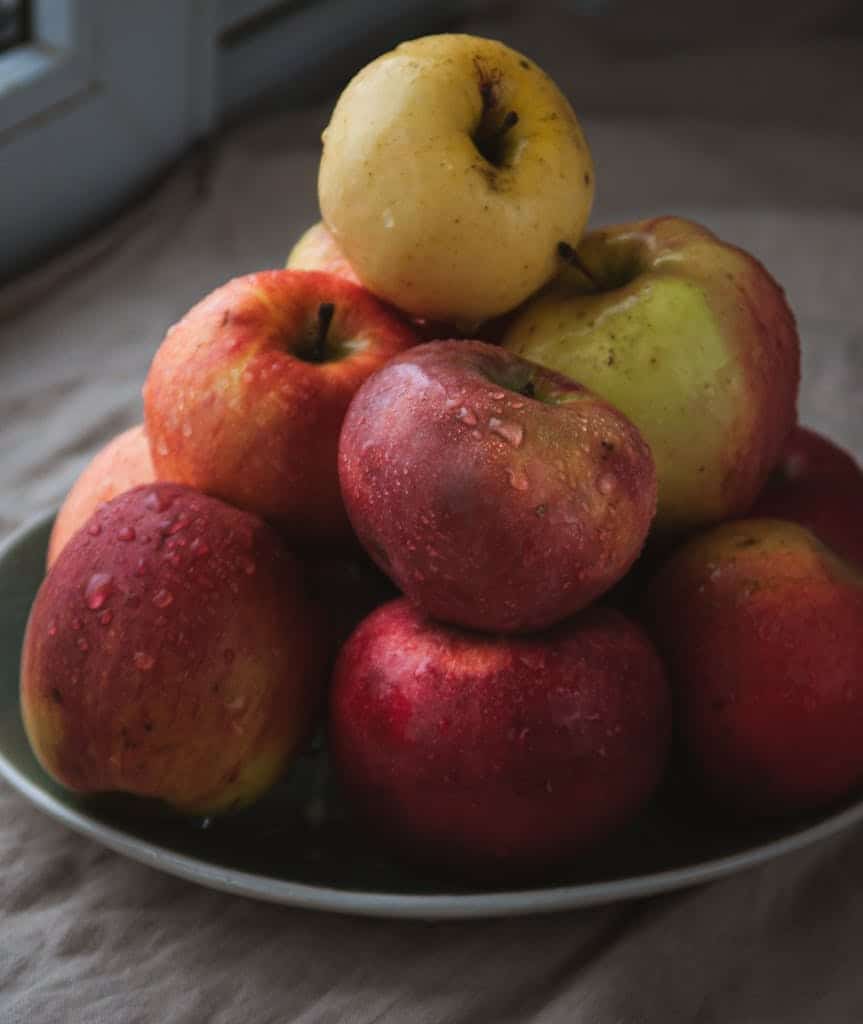
Best Apple Varieties for Healthy Baking: Choose the Right One for Your Recipes
When making applesauce to use as a baking substitute, the type of apple you choose can greatly influence the flavor, texture, and overall success of your recipes. Some apples are sweet, others are tart, and each variety brings its own unique set of characteristics that can either enhance or detract from your baked goods, depending on how you use them. Whether you’re using applesauce as a substitute for oil, butter, or sugar, here’s a guide to picking the best apple varieties for your needs.
Replacing Oil or Butter: Fuji, Gala, and Golden Delicious
Using applesauce to replace oil or butter in baking is a great way to reduce fat while keeping your treats moist and tender. For this purpose, sweet apple varieties like Fuji, Gala, and Golden Delicious are excellent choices. These apples have a naturally high sugar content, which means they won’t require additional sweetening when used in recipes. Their mild, sweet flavor won’t overpower other ingredients, making them a versatile choice for a wide range of baked goods.
- Pros: High natural sugar content, great for moisture, doesn’t overpower other flavors.
- Cons: May lack the depth of flavor that tart apples bring; May make the final product slightly sweeter, so adjust other sugars if needed.
If you’re looking to keep things simple and straightforward, these sweet varieties are perfect for substituting oil in cakes, muffins, and quick breads. They add moisture without altering the overall flavor profile too much, allowing the other ingredients to shine.
To substitute in your recipes, use a 1:1 ratio of freeze dried applesauce powder and equal parts water to replace oil or butter.
Replacing Eggs: Honeycrisp, Pink Lady, and Jonagold
When substituting eggs, the goal is to find apples that offer good binding properties and the right amount of moisture. Honeycrisp, Pink Lady, and Jonagold apples strike a good balance between sweetness and tartness, making them ideal for this purpose. Their pectin content helps provide structure, similar to what eggs would do.
- Pros: Balanced flavor, good binding properties, adds moisture.
- Cons: May not provide as much rise as eggs, so recipes may be slightly denser.
To substitute in your recipes replace each egg with 1/4 cup of freeze dried applesauce powder and 1/4 cup of water.
Replacing Sugar: Honeycrisp, McIntosh, Pink Lady
Honeycrisp, McIntosh, and Pink Lady apples are perfect for replacing sugar in your baking. These varieties are known for their natural sweetness and flavorful profiles. Using applesauce made from these apples can add a sweet, fruity taste to your baked goods without the need for added sugars, making them an excellent choice for healthier treats.
- Pros:
- Natural Sweetness: Honeycrisp, McIntosh, and Pink Lady apples provide a natural sweetness that can help reduce or eliminate the need for added sugars in your recipes. This makes your baked goods healthier and perfect for those watching their sugar intake.
- Cons:
- Flavor Variation: The distinct fruity flavors of these apples can sometimes alter the taste of your baked goods. While this can be delightful in some recipes, it may not work as well in others where a more neutral flavor is desired.
Tart Varieties to add Depth: Granny Smith, Braeburn, and McIntosh
When substituting applesauce for sugar, tart apple varieties like Granny Smith, Braeburn, and McIntosh are your best bet. These apples offer a sharper, tangy flavor that balances the natural sweetness of the applesauce. This can help to cut through the richness of other ingredients, like chocolate or nuts, and provide a more nuanced flavor to your baked goods. Tart apples also tend to have a firmer texture, which can translate to a thicker, more structured applesauce.
- Pros: Adds depth of flavor, balances sweetness, often has a firmer texture.
- Cons: Can be too tart for some recipes, may require additional sweetening depending on your taste preferences.
Tart apples work especially well in recipes where you want a contrast to the sweetness, like in spice cakes, gingerbread, or hearty muffins. Their bright flavor can enhance the overall taste of the dish, making it feel fresher and less heavy.
Balanced Varieties for Versatility: Honeycrisp, Pink Lady, and Jonagold
If you’re looking for apples that can do it all, balanced varieties like Honeycrisp, Pink Lady, and Jonagold are the way to go. These apples offer a harmonious blend of sweetness and tartness, making them ideal for a wide range of baking substitutions. They’re great for replacing both oil and sugar, as they add moisture and sweetness without leaning too heavily in one direction.
- Pros: Versatile, balanced flavor, works well in most recipes, adds both moisture and sweetness.
- Cons: Can be more expensive; sometimes lacks the specific punch of sweet or tart apples.
Balanced apples are a great all-around choice if you’re stocking up for multiple baking projects. They’re perfect for everything from cookies and bars to cakes and muffins, providing a reliable substitute that won’t overwhelm your recipes.
Using a Mix of Apples for Complexity
For those who love a bit more complexity in their baking, mixing different varieties of apples is a great strategy. Combining sweet and tart apples can give your applesauce a layered flavor that enhances your baked goods in unexpected ways. For instance, blending Fuji with Granny Smith can offer the best of both worlds—sweetness and a touch of tang.
- Pros: Creates a more complex, interesting flavor, can be customized to suit different recipes, balances moisture and sweetness.
- Cons: Requires more effort to prepare, may need taste adjustments to find the right balance.
Mixing apples is particularly useful in recipes like apple spice muffins, fruit breads, or any dessert where apples are a featured ingredient. By blending varieties, you can control the sweetness and tartness levels to perfectly complement your dish.
Choose Organic Apples When Available
When making freeze-dried applesauce for healthy baking, using organic apples is highly recommended. Non-organic apples are often listed among the most pesticide-contaminated fruits, with studies showing that they can contain residues of multiple pesticides even after washing. According to the Environmental Working Group’s 2023 report, apples ranked fourth on their “Dirty Dozen” list, highlighting the high levels of pesticide contamination found in conventional apples. Choosing organic apples helps you avoid these chemicals, ensuring that your freeze-dried applesauce remains a truly healthy and clean ingredient for your baking needs.
Nutritional Benefits of Applesauce
“An apple a day keeps the doctor away” is a popular saying for good reason—apples are packed with fiber, vitamins, and antioxidants that support overall health. However, how you process apples can significantly impact their nutritional value. Cooking or processing apples into applesauce can reduce some heat-sensitive nutrients and since many nutrients in the apple are in the skin the choice to remove the skin can have a significant impact on the nutritional value.
Fresh Raw Apple vs Applesauce
When you compare applesauce to a fresh raw apple, there are some clear differences in terms of nutrition. Fresh apples have the highest fiber content, maximum levels of vitamin C, and the most antioxidants because nothing is removed during preparation. Eating a raw apple provides a satisfying crunch and chewing experience, which can also help you feel fuller longer due to the physical act of eating.
Applesauce typically has slightly less fiber and vitamins because some nutrients are lost during cooking. However, it’s still a nutritious option and has the added benefit of being more versatile for cooking, baking, or as a snack on its own.
Applesauce with the Peel
When you make applesauce with the peel, you’re retaining much of the fruit’s fiber content, which is one of the key health benefits of apples. A medium apple with the peel contains about 4.4 grams of fiber, which helps support healthy digestion, keeps you full longer, and can even aid in regulating blood sugar levels. The peel also contains a significant amount of vitamins, particularly vitamin C, which supports immune function and skin health.
Moreover, apple peels are rich in polyphenols, which are antioxidants that have been linked to reduced inflammation and improved heart health. These compounds help fight free radicals in your body, protecting your cells from damage. Applesauce made with the peel tends to have a slightly thicker texture and more robust flavor, making it an excellent choice for those who want the maximum nutritional benefit.
Applesauce Without the Peel
Applesauce made without the peel is often chosen as a way to ensure a smoother texture and it is still nutritious, but it loses some of the benefits found in the peel. Without the peel, applesauce contains less fiber—around 1 to 2 grams per serving compared to the 4.4 grams in a whole apple. It also has lower levels of antioxidants, as many of these compounds are concentrated in the peel.
If a softer smoother texture is a priority, applesauce without the peel is still a good source of vitamin C and potassium, both of which are essential for overall health. It’s also easier to digest, which can be beneficial for people with sensitive digestive systems or specific dietary restrictions.
Homemade Applesauce: Control Your Ingredients, Quality, and Safety
Homemade applesauce is ideal because it gives you complete control over the ingredients and preparation, allowing you to decide which variety and whether to keep the peel for added fiber or adjust the texture to your liking. This ensures you’re making the best choices for your health and dietary needs, as well as what is best for the recipes you intend to create. Plus, by making applesauce at home, you significantly reduce the risk of contamination that can occur in commercial processing or supply chains—like the recent concerns over lead exposure in store-bought applesauce revealed by FDA findings. For more information, you can read about these findings in detail from Consumer Reports: FDA finds elevated lead levels in applesauce. With homemade, you know exactly what goes into your food, making it a safer and healthier option.
Homemade Unsweetened Applesauce Recipe
Healthy baking with freeze dried applesauce starts with making your own applesauce at home, allowing you to control the ingredients and keep it pure. Making your own unsweetened applesauce is simple and lets you control exactly what goes into it. Whether you keep the peel for added nutrients or prefer a smoother version without, homemade applesauce is a versatile ingredient perfect for many recipes. Keeping it unsweetened and unspiced allows you to adapt it to any dish, but if you’re craving a bowl of applesauce, you can always sweeten and spice it up as desired. Here’s how to make it on the stovetop, in the Instant Pot, or using a slow cooker!
Ingredients:
- 4-5 medium apples (refer to the information above about apple varieties to help you choose)
- 1 cup water
- 1 tablespoon lemon juice (optional, to preserve color)
Stovetop Method
- Wash and Prep Apples: Wash, peel (if desired), core, and chop apples.
- Cook the Apples: In a medium pot, combine apples, water, and optional lemon juice. Bring to a boil over medium-high heat.
- Simmer: Reduce heat and simmer, covered, for 15-20 minutes until apples are soft, stirring occasionally.
- Blend: Use an immersion blender in the pot or transfer to a blender/food processor for your preferred consistency.
- Adjust Consistency: Add more water if needed
- Cool and Store: Cool before storing in jars. Refrigerate for up to a week or freeze dry for longer storage.
Instant Pot Method
- Prepare Apples: Wash, peel (if desired), core, and chop apples.
- Add to Instant Pot: Place apples, water, and lemon juice into the Instant Pot.
- Pressure Cook: Seal the lid and set to “Pressure Cook” on high for 5 minutes. Allow natural release for 10 minutes.
- Mash or Blend: Use a masher for chunky applesauce or blend for a smooth finish.
- Cool and Store: Store as directed above.
Slow Cooker Method
- Prepare Apples: Wash, peel (if desired), core, and chop apples.
- Add to Slow Cooker: Place apples, water, and lemon juice in the slow cooker.
- Cook: Cover and cook on low for 6-8 hours or high for 3-4 hours, until apples are soft.
- Mash or Blend: Mash for a chunkier sauce or blend for a smoother texture.
- Cool and Store: Store as previously instructed.
Tips for Flavoring Your Applesauce:
This flexible, unsweetened applesauce is ideal for baking and cooking, so it won’t infere with any recipe you plan to use. But if you choose to enjoy your applesauce as a snack, you can always sweeten or spice it up to your liking. Below are some my favorites!
- Sweeteners: Add honey, maple syrup, or agave nectar after cooking for a sweeter taste.
- Spices: Stir in cinnamon, nutmeg, or cloves for a spiced twist.
- Fruit Add-Ins: Incorporate other fruits like pears, berries, or mango for a unique flavor. My kids especially like strawberries added.
- Salt: Add a pinch of salt to the recipe to enhance the natural sweetness of the apples and balance the flavors.
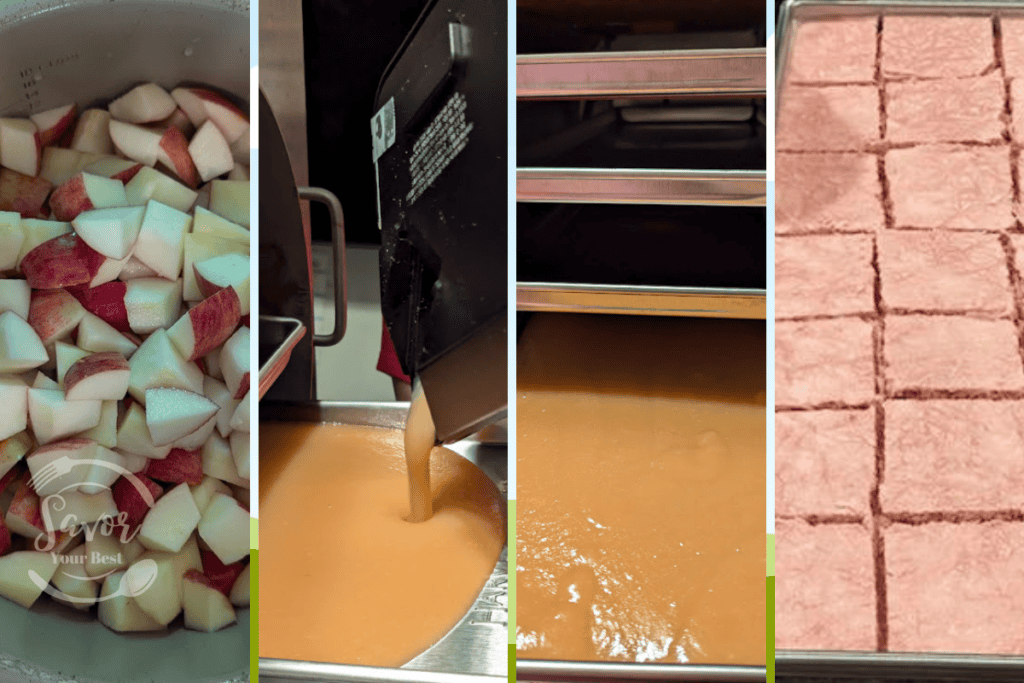
How to Freeze Dry Applesauce
- Prepare the Applesauce: Once your applesauce has cooled completely, ensure it has a smooth consistency. If needed, give it a quick blend to remove any lumps. This will help the applesauce freeze dry evenly.
- Spread on Freeze Dryer Trays: Using a spatula spread the cooled applesauce in a thin, even layer on the freeze dryer trays. Aim for a thickness of about 1/4 inch to 1/2 inch. Thinner layers will freeze dry more efficiently and evenly. (You can also divide your applesauce into molds to create individual servings- since I planned to powder this batch, I did not do this, but if I were not going to powder, I would always put my applesauce in molds)
- Pre-Freeze the Trays (Optional): For quicker freeze drying, consider pre-freezing the trays in your freezer for a few hours or overnight. This step isn’t mandatory but can reduce the total freeze drying time.
- Load the Freeze Dryer: Carefully place the trays into your Harvest Right Freeze Dryer. Ensure the trays are level to prevent the applesauce from pooling to one side.
- Start the Freeze Drying Process: Close the freeze dryer door securely and start the machine. Select the appropriate settings for fruits or customized settings if your machine allows. The freeze drying process will typically take around 24-36 hours, depending on the thickness and moisture content of the applesauce.
- Check for Complete Freeze Drying: Once the cycle is complete, check that the applesauce is fully freeze dried. It should be light, dry, and crumbly with no cold spots. If it still feels slightly cool or damp, run an additional drying cycle.
- Remove and Store: Once fully freeze dried, remove the trays and break the applesauce into chunks or crumble it into smaller pieces. (Or scroll down to learn how to make powder.) Store in airtight containers, Mylar bags with oxygen absorbers, or vacuum-sealed jars to keep it fresh and ready for long-term storage.
- Label and Date: Don’t forget to label your containers with the contents and date of freeze drying. Properly stored, freeze dried applesauce can last for up to 25 years.
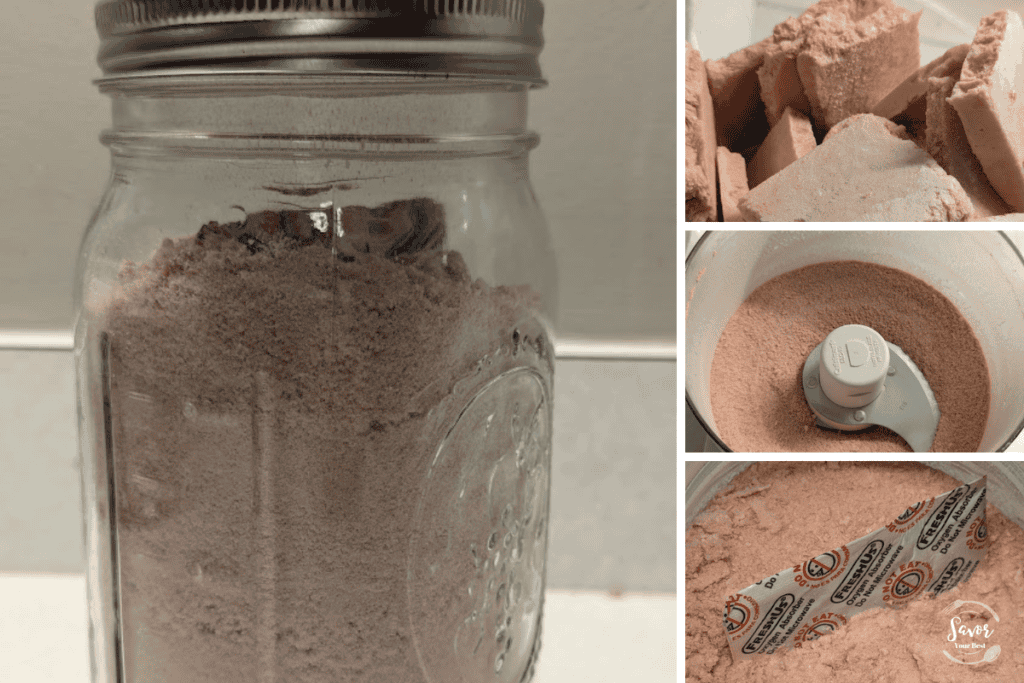
Making Freeze Dried Applesauce Powder for Baking
After freeze drying your applesauce, you can take it a step further by turning it into a fine powder that’s perfect for baking. Simply break up the freeze dried applesauce into chunks and place them in a food processor or blender. Pulse until you achieve a fine, powdery consistency. This applesauce powder is a versatile ingredient that you can keep on hand to add a healthy, natural boost of flavor to your baked goods.
For long-term storage, place the applesauce powder in Mylar bags with oxygen absorbers and seal them tightly. This method keeps the powder fresh and protected from moisture, allowing it to last for years. For short-term use, store the powder in airtight containers or Ball jars with oxygen absorbers. Keep a jar handy in your pantry for whenever you’re baking—you’ll find it’s a convenient way to add apple flavor and nutrients without the hassle of fresh applesauce.
Conclusion
Using freeze dried applesauce is a simple swap that not only makes your baked goods healthier but also adds a natural sweetness and extra fiber. It’s a great way to cut down on fats and sugars without sacrificing taste or texture.
So, next time you’re baking, don’t just stick to the usual ingredients. Reach for your homemade freeze dried applesauce and get creative! You’ll end up with treats that are not only healthier but also packed with all the goodness of apples. It’s a simple change that can make a big difference in your health and wellness journey, turning indulgent baked goods into nutritious snacks you can feel great about enjoying

